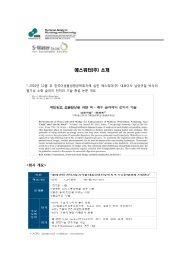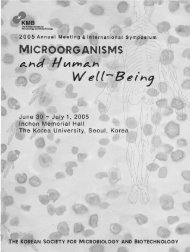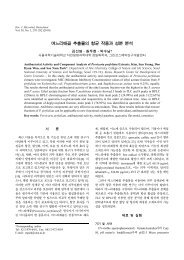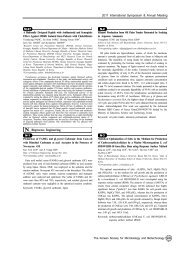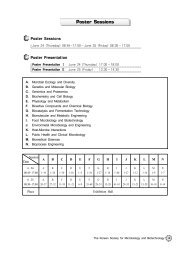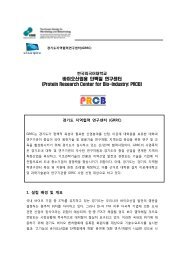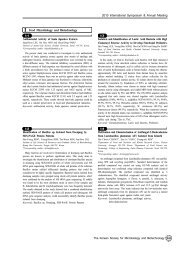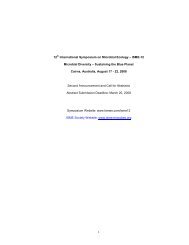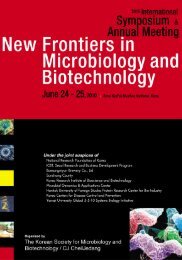J_Environmetal Microbiology and Engineering
J_Environmetal Microbiology and Engineering
J_Environmetal Microbiology and Engineering
You also want an ePaper? Increase the reach of your titles
YUMPU automatically turns print PDFs into web optimized ePapers that Google loves.
Characterization of Phosphate-Solubilizing Bacteria Isolated from<br />
Soil<br />
Ah Ra CHO 1 , Jae Gon KANG 2 , Hoon Seok KANG 2 <strong>and</strong> Dae Ook KANG* 1<br />
1<br />
Department of Biochemistry <strong>and</strong> Health Science, Changwon National University,<br />
Changwon 641-773, Korea. 2 J-8<br />
Korea Biochemical Inc., Igok-ri, Munsan-eup, Jinju<br />
660-841, Korea.<br />
*Corresponding author: biochem1@changwon.ac.kr<br />
Bacteria capable of forming halos on Pikovskaya's agar medium were<br />
isolated from soil as an effort to develop microbial agent for the amendment<br />
of inorganic phosphate-accumulated soil. Five bacterial isolates were<br />
finally selected <strong>and</strong> identified using biochemical <strong>and</strong> molecular taxonomy.<br />
Four isolates were identified as Acinetobacter calcoaceticus <strong>and</strong> the one<br />
Pantoea sp. Phosphate-solubization activity gradually increased for 7-day<br />
growth, which was verified by reciprocal decrease in elctronic conductance.<br />
The optimal temperature <strong>and</strong> initial pH were 30 o C <strong>and</strong> 5.0 - 6.0,<br />
respectively. The addition of 3% of NaCl had no effect on cell growth.<br />
We selected optimal C-, N-source <strong>and</strong> inorganic salts. The Pantoea sp.<br />
showed 1-aminocyclopropane-1-carboxylic acid (ACC) deaminase. We<br />
examined 2D protein expression profies of three isolates between normal<br />
<strong>and</strong> salt stressed (4% NaCl) culture condition.<br />
Keywords: ACC deaminase, electronic conductance, optimal temperature,<br />
pH, phosphate-solubilizing bacteria,<br />
Laboratory Evaluation of Entomopathogenic Fungi for Control<br />
of Green Peach Aphid Myzus persicae<br />
Van Hanh VU* 1 , Thi Thuy Duong LE 2 , Dinh Thi QUYEN 2 <strong>and</strong> Keun KIM 3<br />
1<br />
Institute of Biotechnology, Vietnam Academy of Science <strong>and</strong> Technology, Hanoi<br />
10600, Vietnam/ Department of Bioscience <strong>and</strong> Biotechnology, The University of<br />
Suwon, Hwaseong-si 445-743, Korea. 2 Institute of Biotechnology, Vietnam<br />
Academy of Science <strong>and</strong> Technology, Hanoi 10600, Vietnam. 3 J-9<br />
Department of<br />
Bioscience <strong>and</strong> Biotechnology, The University of Suwon, Hwaseong-si 445-743,<br />
Korea.<br />
*Corresponding author: vvhanh@ibt.ac.vn<br />
Twenty seven entomopathogenic fungal strains were isolated from<br />
various infected aphids. One fungus exhibited the highest virulence<br />
towards green peach aphids, Myzus persicae. The isolate conformed most<br />
closely to Lecanicillium sp. based on the sequence of internal transcribed<br />
spacer region of its 28S rDNA, <strong>and</strong> thus was designated as Lecanicillium<br />
sp. Le85. The laboratory bioassay for the aerial conidia of Le85 was<br />
performed for the control of M. persicae. After six days of application<br />
with 1×10 8 aerial conidia/ml, at 20~25 o C <strong>and</strong> relative humidity of 75~85%,<br />
the mortality of aphid by Le85 was about 97% with LT50 of 3.2 days.<br />
Meanwhile, at 26~31 o C <strong>and</strong> relative humidity of 60~70%, the evaluations<br />
of Le85 on potted cabbages showed an aphid mortality ranging from 82<br />
to 95%. Significant conidiation was observed on the aphid cadavers<br />
infected with Le85. Undoubtedly, the results suggest that Le85 can be<br />
used as a biocontrol agent for aphid M. persicae on cabbages in<br />
greenhouses.<br />
Keywords: Myzus persicae, entomopathogenic fungi, Lecanicillium sp.,<br />
398 www.kormb.or.kr<br />
Glucose Utilization <strong>and</strong> Electricity Generation Using Genetically<br />
Modified Shewanella Strains<br />
DongGeon CHOI 1 , Sae Bom LEE 1 , In Geol CHOI 2 <strong>and</strong> In Seop CHANG* 1<br />
1<br />
School of Environmental Science <strong>and</strong> <strong>Engineering</strong>, Gwangju Institute of Science<br />
<strong>and</strong> Technology(GIST), 261 Cheomdan gwagi-ro, Buk-gu, Gwangju 500-712,<br />
Korea. 2 J-10<br />
College of Life Science <strong>and</strong> Biotechnology, Korea University, Anam-dong,<br />
Sungbuk-gu, Seoul 136-701, Korea.<br />
*Corresponding author: ischang@gist.ac.kr<br />
Genomic sequence analyses of Shewanella strains have been studied<br />
for carbon metabolism as well as their physiological characteristics. Even<br />
though Shewanella strains seem to have glycolysis pathways <strong>and</strong> enzymes<br />
as central carbon metabolism, several key enzymes are missing.<br />
Shewanella strains also have only one set of phosphotransferase system<br />
to uptake simple sugar like glucose through the membrane. So, it is unclear<br />
that Shewanella strains can utilize six-carbon carbohydrates (e.g. glucose)<br />
as carbon <strong>and</strong> energy source. In this study, Shewanella oneidensis MR-1<br />
was metabolically engineered to have the ability of glucose uptake <strong>and</strong><br />
utilization as carbon <strong>and</strong> energy source. Glucokinase (glk) <strong>and</strong><br />
glucose-facilitated diffusion protein (glf) of Zymomonas mobilis were<br />
cloned into a broad host range plasmid <strong>and</strong> introduced to S. oneidensis<br />
MR-1 to help glucose uptake <strong>and</strong> utilization. This recombinant Shewanella<br />
strain was used for single cell based MFC system in order to confirm<br />
the glucose utilization <strong>and</strong> concomitant with current production. The<br />
results indicated that cloned genes (glf <strong>and</strong> glk) were functional for glucose<br />
utilization in S. oneidensis MR-1 wild type. We also found that this<br />
modification was effective to two Shewanella strains, S. putrefaciens<br />
CN-32 <strong>and</strong> S. loihica PV-4.<br />
Keywords: Shewanella, Glucose, Electricity<br />
Investigation of C<strong>and</strong>idate Strains for Application of Microbial<br />
Electrosynthesis<br />
Saebom LEE 1 , Dong Geon CHOI 1 , In Geol CHOI 2 <strong>and</strong> In Seop CHANG* 1<br />
1<br />
School of Environmental Science <strong>and</strong> <strong>Engineering</strong>, Gwangju Institute of Science<br />
<strong>and</strong> Technology (GIST), 261 Cheomdan-gwagiro, Buk-gu, Gwangju 500-712,<br />
Korea. 2 J-11<br />
College of Life Sciences <strong>and</strong> Biotechnology, Korea University,<br />
Anam-dong, Sungbuk-ku, Seoul 136-701, Korea.<br />
*Corresponding author: ischang@gist.ac.kr<br />
Reducing power which is obtained from microbial metabolism is used<br />
to produce several valuable chemicals such as ethanol, butanol, <strong>and</strong> acetate.<br />
Microbial electrosynthesis is a system that produces chemicals using<br />
electron. In microbial electrosynthesis, electrons supplied from electrode<br />
are accumulated to inner cell <strong>and</strong> are used to produce the reducing power.<br />
The accumulated reducing power can be used to produce chemicals.<br />
Geobacter <strong>and</strong> Shewanella strains, which are well known as metal reducing<br />
bacteria, can deliver electrons to outer metal ions through the arrangement<br />
of cytochrome C protein in the cell membrane. Recently, as reverse<br />
electron flow of Shewanella strain was revealed, it was known to move<br />
outer electrons to inside through cytochrome C protein. Based on this<br />
point, we selected c<strong>and</strong>idate strains which have cytochrome C protein<br />
in the cell membrane <strong>and</strong> can produce valuable chemicals though microbial<br />
reaction. We finally selected Carboxydothermus hydrogenoformans strain<br />
Z-2901 <strong>and</strong> Dethiobacter alkaliphilus AHT 1 which have cytochrome C<br />
protein in extracellular <strong>and</strong> are able to produce valuable chemicals. Two<br />
c<strong>and</strong>idate strains will be used for microbial electrosynthesis.<br />
Keywords: Microbial electrosynthesis; Reverse electron flow





